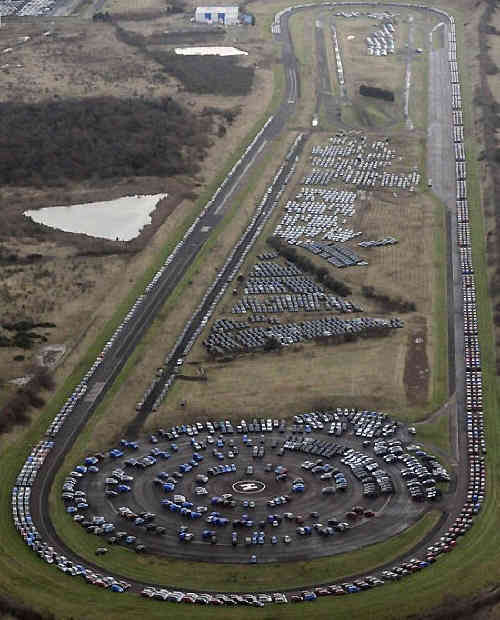Consider the Source. Lots of Unsold Cars Are Normal.

Photograph: Nigel Roddis/Reuters
There’s a post at the Zero Hedge finance site that’s getting some attention. It’s really a repost from this site, and it includes a number of aerial and satellite photos of thousands of new automobiles that the author says are sitting on storage lots, unsold. The author claims that automobile manufacturers are continuing to churn out thousands, perhaps hundreds of thousands of cars that will likely never ever sell. He warns that those cars that do sell will suffer mechanical issues from having sat for so long. He claims that those cars that don’t sell are recycled and that it’s all a sham to keep assembly lines churning. The author also doesn’t know what he’s talking about.
In reposting the article, Zero Hedge amplifies the original author’s claim by accusing General Motors of “channel stuffing” since the automaker’s inventory of unsold vehicles in April was up to 85 days’ supply, a post bankruptcy high. I’m not going to even try to defend GM, but I will point out that while that’s indeed higher than the 60 days’ supply that’s considered healthy in the industry (too low an inventory means that some people who want to buy a model can’t get it in a timely fashion and they end up shopping elsewhere) it’s nowhere near what have historically been considered crisis levels. It should also be pointed out that even when inventories are at that ideal 60 days’ supply, you’d easily be able to take photographs of thousands of cars sitting on storage lots awaiting delivery to dealers. I haven’t checked the SAAR level for U.S. car and light trucks sales in April but it’s been running at or above 16 million units a year in recent months. That means that a 60 day supply is about 2.66 million unsold cars.
Most of the photos are of European locations. The European market has been soft for years and only recently has shown signs of bottoming out or even a slight improvement so it shouldn’t be surprising that some manufacturers have lots (in both senses of the word) of unsold cars. The image above shot by Nigel Roddis of Reuter, though, was taken of Nissan’s UK test track at Sunderland back in 2009, one of the worst years in automotive history, the year that General Motors and Chrysler had to file for bankruptcy. In 2009 the Sunderland test track couldn’t be used to test cars because it was filled with unsold cars.
Roddis’ photo was one of the images reproduced in the article reposted at Zero Hedge. The original author, Vincent Lewis, is the author of a book about conspiracy theories and I get the impression that he’s a believer in such things. How much he knows about the auto industry is open to question. His post never mentions what normal inventory levels are, nor does he reveal the dates of the photographs of thousands of unsold cars that he uses. Lewis does say that when he recently checked the Sunderland track on Google’s satellite view, all those cars had disappeared. Now those of us who know something about how the car industry works might foolishly assume that in the 5 years since the photograph was taken, most of those cars were delivered to dealers. Instead of telling us how old the photo is, he expresses skepticism that they were all “suddenly” sold and then guesses (his own word) that all of those cars were sent to the crusher, so as to continue the charade that they are making and selling cars:
UPDATE: Currently May 16th, 2014, all of these cars at the Nissan Sunderland test track have disappeared? Now I don’t believe they have all suddenly been sold. I would guess they may have been taken away and recycled to make room for the next vast production run.
Another photograph that Lewis uses is of 57,000 unsold vehicles sitting at the Port of Baltimore. A quick search for [57,000 and Port of Baltimore] shows that the original story about that number of unsold cars stored at the port was published also in 2009, though Lewis gives the implication that those cars are still sitting there. How little Lewis knows about the auto industry can be seen from the fact that the vehicles in the photo are Chrysler Aspens. The Aspen was an upscale fullsize SUV that was discontinued by the 2010 model year. The Aspen didn’t sell well, but if Lewis can guess that Nissan crushed thousands of new cars just to keep their factories running, I can guess that in 2014, there aren’t 57,000 unsold new-old-stock Chrysler Aspens.
Not all of the photos are old. Lewis takes the effort to provide the timestamp on a photo of a storage lot near the port of Sheerness, UK that shows Google’s most recent view of the port from outer space. While there are indeed thousands of cars sitting at the port, what Lewis doesn’t tell you is that Sheerness is one of the leading ports for the importation of cars to the United Kingdom. While manufacturers do inventory thousands of cars somewhere near the assembly plants where they are built, they’re not likely to take the expense of putting them on a boat and shipping them overseas for storage there.
Now normally I would ignore the dreck that flows from the mouths of conspiracy lunatics, but I’ve noticed that a number of politically oriented sites have linked to the Zero Hedge post without realizing that it’s based on very little factual information. What little factual information there is in fact “based” on old photographs. While the photos may be dramatic they and Lewis’ post are not necessarily indicative of anything that’s going on today.

Ronnie Schreiber edits Cars In Depth, the original 3D car site.
More by Ronnie Schreiber
Latest Car Reviews
Read moreLatest Product Reviews
Read moreRecent Comments
- ToolGuy 9 miles a day for 20 years. You didn't drive it, why should I? 😉
- Brian Uchida Laguna Seca, corkscrew, (drying track off in rental car prior to Superbike test session), at speed - turn 9 big Willow Springs racing a motorcycle,- at greater speed (but riding shotgun) - The Carrousel at Sears Point in a 1981 PA9 Osella 2 litre FIA racer with Eddie Lawson at the wheel! (apologies for not being brief!)
- Mister It wasn't helped any by the horrible fuel economy for what it was... something like 22mpg city, iirc.
- Lorenzo I shop for all-season tires that have good wet and dry pavement grip and use them year-round. Nothing works on black ice, and I stopped driving in snow long ago - I'll wait until the streets and highways are plowed, when all-seasons are good enough. After all, I don't live in Canada or deep in the snow zone.
- FormerFF I’m in Atlanta. The summers go on in April and come off in October. I have a Cayman that stays on summer tires year round and gets driven on winter days when the temperature gets above 45 F and it’s dry, which is usually at least once a week.


































Comments
Join the conversation
Sites like Zero Hedge are great, because they convince conspiracy theorists to put their money where their mouth is. That way, the rest of us can profit from their foolishness. (Now there's a conspiracy theory...)
I am amazed that "investigators " actually try to use Google sat view and street view as evidence. These are old pictures. Leads me to assume they are ignorant hacks. I just looked at my yard. The latest possible date was last summer (trees in full bloom but recent construction missing